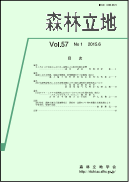All issues

Volume 56 (2014)
- Issue 2 Pages 71-
- Issue 1 Pages 1-
Volume 56, Issue 2
Displaying 1-6 of 6 articles from this issue
- |<
- <
- 1
- >
- >|
-
Koji Shichi, Tsuyoshi YamadaArticle type: Preface
2014Volume 56Issue 2 Pages 71-73
Published: December 25, 2014
Released on J-STAGE: April 03, 2017
JOURNAL FREE ACCESSDownload PDF (348K) -
Kenichiro TodaArticle type: Comment
2014Volume 56Issue 2 Pages 75-79
Published: December 25, 2014
Released on J-STAGE: April 03, 2017
JOURNAL FREE ACCESS -
Toru OkamotoArticle type: Comment
2014Volume 56Issue 2 Pages 81-87
Published: December 25, 2014
Released on J-STAGE: April 03, 2017
JOURNAL FREE ACCESSDownload PDF (1464K) -
Kazuo Isobe, Nobuhito OhteArticle type: Report
2014Volume 56Issue 2 Pages 89-95
Published: December 25, 2014
Released on J-STAGE: April 03, 2017
JOURNAL FREE ACCESS -
Stand structure after clear-cutting of coniferous plantations in southern Wakayama Prefecture, JapanYumiko Nakamori, Tsuyoshi KuriuArticle type: Article
2014Volume 56Issue 2 Pages 97-106
Published: December 25, 2014
Released on J-STAGE: April 03, 2017
JOURNAL FREE ACCESSWe investigated the stand structure of plantation sites clear-cut 10-24 years ago in the warm-temperate zone of southern Wakayama Prefecture, Japan. We examined differences in stand characteristics among vegetation types. In the study stands (29 study plots, mainly 10 × 10 m), the mean stem density of trees more than 1 cm in diameter at breast height were censused. Stands were classified into four types characterized by differences in micro-topography, the number of years after harvesting, and altitude: shade-intolerant and pioneer type, evergreen broad-leaved type I, conifer type, and evergreen broad-leaved type II. Evergreen broad-leaved type I (dominated by Quercus glauca and Castanopsis species) were distributed across convex topography, whereas shade-intolerant and pioneer type (mainly consisting of Cinnamomum camphora, Lindera erythrocarpa, and Zanthoxylum ailanthoides) were distributed within concave topography. In shade-intolerant and pioneer type and evergreen broad-leaved type I, the stem density, basal area and mean height of non-pioneer trees, which are indicators of qualitative recovery in the vegetation, increased with increasing stand basal area, which are indicators of quantitative development in the vegetation. However, the stem density and basal area of non-pioneer trees did not increase with increasing the number of years after cutting. These results indicate that recoveries of these two vegetation types were similar; when sufficient numbers of trees became established and grew, the vegetation recovery appeared to progress. In the study sites, the two vegetation types seemed to have similar stand structure in terms of the amount of non-pioneer trees, except the difference in individual tree species.View full abstractDownload PDF (1711K) -
Teruyuki Muto, Hiromasa KoyamaArticle type: Report
2014Volume 56Issue 2 Pages 107-110
Published: December 25, 2014
Released on J-STAGE: April 03, 2017
JOURNAL FREE ACCESS
- |<
- <
- 1
- >
- >|